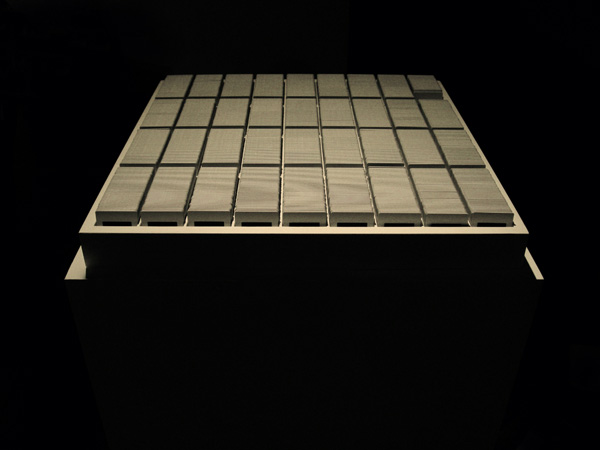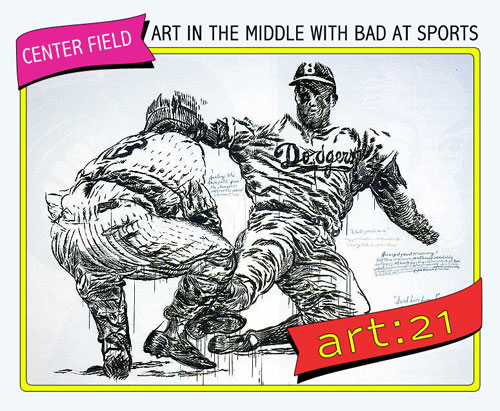On February 23, artist Katie Paterson gave a talk at The Art Institute of Chicago. Of the many works discussed, she described Earth-Moon-Earth (Moonlight Sonata Reflected Off the Surface of the Moon), a work from 2007 in which she took Beethoven’s infamous sonata, translated it into morse code and sent it to the moon via radio transmission. She waited for the sonata to bounce back. Apparently there is a whole network of people who do this: transmit and collect messages to and from the moon’s surface. These self-identified “moon bouncers” set up small transmitters in their backyards and spend evenings snatching encoded sentences from the ether. They have to decipher meaning in what they find, for some of each message gets lost in its return: patches of code are swallowed and mislaid due to the moon’s irregular surface, combined with unpredictable weather patterns that bend or skew the sound waves on which our messages rely.
Paterson’s art piece is both a visual and audio representation of this distortion. When exhibiting this work, she hangs the original Morse code transcript beside its lunar twin. Whole passages of text are visibly missing. She re-translated that Morse code back into musical notation and sets up a self-playing piano in the corner of a gallery. Because the piano bench is not immediately visible, one would assume a pianist would be there, especially given the score’s coherent beginnings. At first the sonata occurs according to Beethoven’s intentions. After a few minutes it deteriorates. Seconds of silence endure where one expects a sequence of notes. Yet the silence has kept its own time and when the music resumes, it does so in league with its origin. In walking towards the piano, turning the corner of its slick wooden lid, you see an empty bench. The spirit of the moon is conjured in the emptiness, it feels like an active presence in that it has swallowed, or withheld, something of the original sonata. “By encoding information, absences become present,” Paterson said during her talk, “and presence become audible.”

Katie Paterson. "Earth–Moon–Earth (Moonlight Sonata Reflected from the Surface of the Moon)," 2007. Morse code received from the moon.
Paterson is trying to engage a reciprocal action from an impossible surface. She is sending a message through the empty space around the Earth — a Romantic message of longing, perhaps like a poet engaging the natural world. She wants to have some influence in Outer space, to communicate with the massive emptiness of sky. Paterson exercises a very literal projection, receiving in response the passive reflection of her effort. Any feeling we might glean from the reply is only a projection, emanating from within the human mind. We might imagine the moon as an imperfect mirror. That is not to say that the moon does not act, but rather that it does not act according to our linguistic terms. Instead it pulls our tides and oceans. The beauty of Paterson’s piece stems from the failure of repetition, the moon’s absent voice, like a letter that has been returned unopened, with mangled and water-stained edges: the signs of deterioration reflect a distance traveled while remaining nevertheless unfulfilled.
Shortly after seeing Paterson’s talk, I went to Theater Oobleck’s performance of The Hunchback Variations — a show that closed fairly recently after an extended run. In this opera, Ludwig van Beethoven (played by George Andrew Wolff) and the Hunchback of Notre Damn (played by Larry Adams) sit side by side, as if on a conference panel. Over the course of several, seated arias, Beethoven and Quasimodo present a fraught collaboration, in which they relay their attempts to concretely recreate a mysterious sound from Chekhov’s The Cherry Orchard. “Suddenly a distant sound is heard. It seems to come from the sky and is the sound of a breaking string. It dies away sadly” (Chekhov, Act Two). This sound occurs in the Second Act, just before the family discovers its inherited orchard has been sold (and will be cut down). One character, Gaeve, has just addressed Nature, “thou art wonderful, thou shiniest with eternal radiance!..thou containest in thyself existence and death…” after which these friends sit, together in a field, by a dilapidated temple in silence, listening, it seems, to the natural world around them. The sound interrupts their thoughts and none of the characters can place it, although they all remark on how uncanny and uncomfortable it is. This is the sound they are trying to express in The Hunchback Variations. Yet Beethoven and Quasimodo both have impaired hearing, Beethoven has not finished reading the play, and Quasimodo lives in a swamp where they must meet (presumably because Beethoven does not want Quasimodo in his own clean, sunlit residence). Beyond these practical obstacles they are engaged in an impossible task, for no such sound exists. The pursuit and study of this sound thus becomes a vehicle for Quasimodo and Beethoven’s relationship, but they are looking to recreate a phrase belonging to “Nature.” (You can see a short clip of the performance in the video below).
[youtube:https://www.youtube.com/watch?v=ixaGOdnBwiw&feature=youtu.be]
In another work by Paterson titled Langjökull, Snæfellsjökull, Solheimajökull, the artist collected water from three glaciers. Having recorded the sound of each glacier melting, she cast three records using that same glacier ice. These were played together in a gallery, until they melted. The sound of the glaciers melting is distorted by the skid of the record needle on ice, and then, eventually dissolves into nothing, as the record disappears in a puddle. Here again, there is a way in which Paterson is transcribing a distant phenomena into analogue terms — themselves nostalgic and physically mechanical — that both contextualize the environment in human terms, while also enacting an impossible distance between (perhaps) the human imagination and the glacier itself.

Katie Paterson. "History of Darkness," 2010. 2200 handwritten slides. Cage Mix, BALTIC Centre of Contemporary Art.
Paterson bumps up against a void again and again using a scientific vernacular. She employs technological advance as a kind of medium, often relying on the expertise of others. In one of my favorite series, History of Darkness, Paterson collects photographs from high-powered telescopes around the world and turns them into slides. Each slide contains a light year notation referring to its distance from the earth. Using these telescopes, you can look back into the past, almost 13 billion light years ago, to a place described as existing shortly after the Big Bang, when the Universe was only 5% as old as it is now, a time before our “cosmic dawn.” It is an incomprehensible beyond, and each slide (even when photographing the same coordinate) is capturing a different location in space/time, because of universe expansion. Through these various images, a viewer sees a portrait of infinite and impossible distances — portraits that are nevertheless totally inaccessible, dark squares of black. The space described in those swatches, while literal, is not commensurate to the human apparatus for understanding, except of course in our imaginations. Only in the imagination can we conceive the darkness our bodies apprehend.





Pingback: Centerfield | Talking to the Moon | Benjamin Phillips
Pingback: Moon Posts | The Lantern Daily